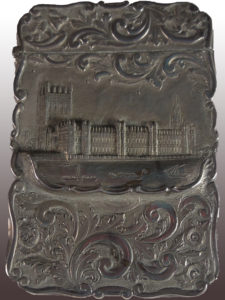Calling Card Case, c. 1890, Nathaniel Mills, Birmingham, England, Sterling silver, Bequest of Judge John Webb Green and Ellen McClung Green, 1957.3.57.
Engraved calling cards formed an important part of the ritual of visiting the homes of friends and acquaintances during the Victorian era. They were often carried by visitors in fancy cases made of silver, tortoiseshell, gold, or horn. Cards were given to a servant who took them directly to the person being called upon, or deposited on a tray for later inspection if the person was out.
A complex etiquette surrounded the cards themselves. By turning down a corner on a card, or initialing it, a caller could indicate the reason for the visit––for example, expressing thanks, congratulations, or condolences.

